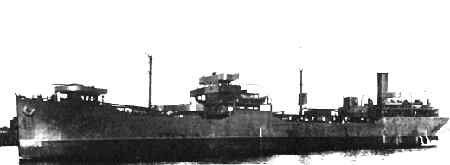USS Laramie (AO 16)
American Fleet oiler

USS Laramie (AO 16)
| Name | USS Laramie (AO 16) | ||
| Type: | Fleet oiler (Kaweah) | ||
| Tonnage | 7,252 tons | ||
| Completed | 1921 - William Cramp & Sons, Philadelphia | ||
| Owner | United States Navy | ||
| Homeport | |||
| Date of attack | 28 Aug 1942 | Nationality: | |
| Fate | Damaged by U-165 (Eberhard Hoffmann) | ||
| Position | 51° 44'N, 55° 40'W - Grid AH 9823 | ||
| Complement | 107 (4 dead and 103 survivors). | ||
| Convoy | SG-6 | ||
| Route | Sydney (26 Aug) - Greenland | ||
| Cargo | 361.000 gallons of aviation gasoline, 55.000 barrels of oil and general cargo, incl. depth charges | ||
| History | Built as Laramie under USSB contract, acquired by the US Navy as fleet oiler at Mobile and commissioned on 28 Dec 1921. On 19 Jun 1922, the oiler was decommissioned at Norfolk. During 1943, the USS Laramie (AO 16) operated again in the North Atlantic, transporting liquid and dry cargo to Greenland from Boston, New York, Sydney, Argentia and St.Johns. From 21 Feb, to 2 Mar 1944, the ship made a run to Aruba for a cargo of gasoline, but then resumed voyages to Greenland out of Boston on 25 March. She returned to Aruba on 28 August and carried fuel to Newfoundland via Guantanamo and Boston from 7 to 27 September. On 17 October, the ship returned to the Caribbean to shuttle liquid cargo between Aruba and Guantanamo. From 9 to 20 November, she steamed to New York via Bermuda and resumed shuttle runs along the East coast to Newfoundland and Greenland. | ||
| Notes on event | At 02.32 hours on 28 Aug 1942, U-165 (Hoffmann) fired a spread of four and a spread of two torpedoes at convoy SG-6 at the north end of Belle Isle Strait in position 51°44N/55°40W (grid AH 9823), heard three detonations and claimed two ships with 10.000 tons sunk and one ship of 5000 tons damaged. In fact, the USS Laramie (AO 16) and the Arlyn were damaged. The USS Laramie (AO 16) (Cmdr P.M. Moncy) was struck by one torpedo on the port side forward, she immediately listed to port and went down by the bow some 37 feet, due to the extensive flooding forward, caused by a hole 41 feet long and 34 feet high. The explosion demolished the forward crew´s quarters, killing four men and ruptured the port gasoline tank, spraying the ship with volatile liquid and explosive fumes. Although gasoline ran ankle deep over the forward gun platforms, no fires broke out and a steam smothering system protected un-ruptured holds. Prompt pumping of liquid cargo corrected the list and reduced the forward draft. The USS Laramie (AO 16) was escorted back to Sydney by the US Coast Guard cutter USS Mohawk (WPG 47), arriving on 30 August. The ship steamed from 2 to 5 September to Boston for damage repairs. The master, Cmdr P.M. Moncy, received the Navy Cross for taking immediate and effective action to save his ship, despite of flooding and imminent danger of explosion. | ||
| On board | We have details of 9 people who were on board. | ||
If you can help us with any additional information on this vessel then please contact us.
